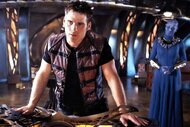Create a free profile to get unlimited access to exclusive videos, sweepstakes, and more!
The Science Behind the Ghostbusters' PKE Meter and Real-World EMF Meters
If you're going to bust ghosts, you need the right tools.
In 1984, the world was introduced to Peter Venkman (Bill Murray), Raymond Stantz (Dan Aykroyd), Egon Spengler (Harold Ramis), and Winston Zeddmore (Ernie Hudson) in the classic paranormal comedy Ghostbusters (now streaming on Peacock). A stacked cast and colorful ghostly special effects captured the imaginations of kids and adults alike, but the real stars were the gadgets.
For decades, kids have been putting on their dads’ jumpsuits, strapping on homemade proton packs, and wielding tissue boxes like PKE meters to hunt down ghosts. In the Ghostbusters universe, the PKE meter (short for Psychokinetic Energy Meter) was invented by Dr. Egon Spengler for the purpose of detecting ghosts, ghouls, demons, and other spectral entities by picking up energy signatures from beyond the veil. Or something.
The PKE meter is a handheld device composed of a handle connected to a central hub. A small screen and a collection of lights indicate any detected activity, but you don’t really need them. Spengler’s device also features a pair of sensor wings which flip out from either side. Watching the wings open and the lights along their length is enough to direct the user to the source of psychokinetic energy. The PKE meter is wholly a Hollywood invention, but if it has a real-world analogue, it’s the electromagnetic field (EMF) meter.
For More on Ghosts:
Casper: The Movie That Made Us Fall in Love with Ghost Devon Sawa
Why Don't People in Ghostbusters Remember the Ghosts?
That Time Kevin Bacon Was Contractually Obligated To Demolish Real-Life Haunted House
What are EMF Meters?
EMF meters are real scientific instruments with legitimate scientific applications, and they are also a favored tool of ghost hunters everywhere. They are designed to detect ambient electromagnetic fields in the environment and they come in two main types. A frequency selective EMF reader pays attention only to a specified set of frequencies within the electromagnetic range while a broadband instrument contains several independent sensors cumulatively capable of detecting a large swath of the EM range.
Electromagnetic fields big and small surround us all the time. There are alternating current (AC) fields coming from your home appliances and electrical wiring and there’s a direct current (DC) field coming from the Earth itself. EMF meters only detect alternating current, if you want to detect DC fields then you need a magnetometer, also called a Gauss meter.
Ghost hunters use them under the premise that ghosts interact with the environment by manipulating electromagnetic fields. A sudden change in the ambient EM field might be taken as evidence of paranormal phenomena, or a microwave on the fritz. They have the benefit of looking and feeling a lot like Spengler’s PKE meter. Small handheld devices with a handle connected to a central hub, often with colored LEDs or small digital displays. The only thing they’re missing are the sensor wings, which are admittedly the coolest part. If you’re the sort of person who might go dowsing for demons, it’s the first thing in your toolkit, but do they do the job they purport to do?
Can EMF Meters Really Detect Ghosts, Like the Ghostbusters' PKE Meter?
There’s no denying that an EMF meter in an abandoned hospital will detect something, but it probably won’t be ghosts. In the ‘90s, Laurentian University neuroscientist Michael Persinger investigated the case of a teenager experiencing nightly visitations from what she interpreted as a divine spirit. Persinger found that a clock near her bed was emitting EM pulses which he hypothesized might be stimulating her frontal lobe and generating the experience of a “sensed presence.” When the clock was removed, the visions stopped.
Persinger went on to perform hundreds of experiments with a device commonly called the “God Helmet,” which sought to induce these experiences in volunteers to better understand the human mind. In those experiments, the way the experience is interpreted is largely cultural. Some people feel as if they’ve visited with a lost loved one, some describe being abducted aliens, and others feel as though they’ve just met God.
There’s still so much we don’t understand about the brain and the way it interprets the environment, but if Persinger is right, then there might actually be a connection between EM field fluctuations and perceived paranormal activity. Even things like shared visions could be explained by an environmental EM field fluctuation triggered a sensed presence in a group with a shared cultural framework. Unlike Spengler’s PKE meter, real-world EMF meters aren’t any good at finding ghosts, but they might be good at finding the sorts of environments where people experience the supernatural.
Ghostbusters and Ghostbusters II are now streaming on Peacock.































